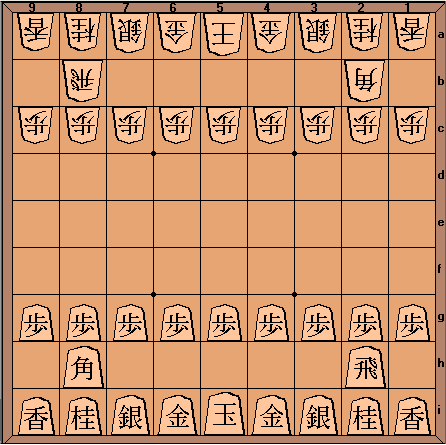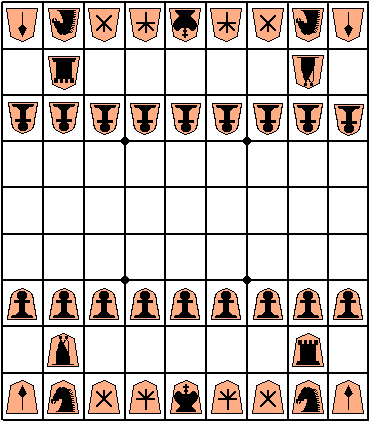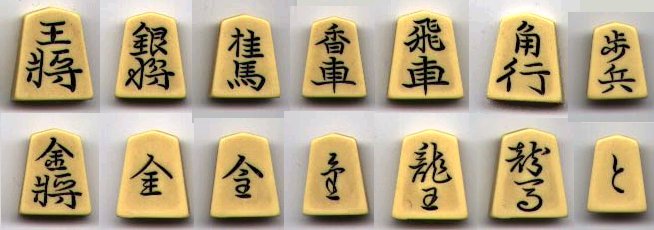Shogi, the Japanese Chess
|
|
|
|
sho |
gi |
Shogi is Japanese Chess, Chess played in Japan. With its original system of promotions and drops, it may pretend to the title of most complex Chess in the World. Shogi is played in competition and has its champions. In Japan, there are professional players, as for Go, the great rival strategy game. Nowadays, there are enthusiast players in many other countries.

Shogi
set-up (author's collection)

Shogi
set-up with conventional pieces (from Steve Evans)

Shogi
set-up with symbolic pieces
SHORT DESCRIPTION:
Shogi is played on the cells of a 9x9 board (shogi-ban). The 3 first raws form the player's camp and the last 3 raws represent his promotion zone. The cells are slightly rectangular - longer than wider - and small points help to visualize the promotion zones.
Each player has 20 men. The pieces are flat and wedge-shaped and are not distinguished by color. Ownership of the pieces is indicated by the direction in which they face, with a player’s pieces always pointing towards the opponent. South (arbitrarily designed as "Black") is named Sente and plays first. North (or "White") is named Gote.
The pieces bear their name with two black ideograms. On the reverse side, they also have the name - in red or in black - of their promoted form (except the King and the Gold General who do not promote). The pieces are the following:

|
Jeweled |
Silver |
Honoured |
Lance |
Flying |
Angle |
Soldier |
|
Gyokusho |
Ginsho |
Keima |
Yari |
Hisha |
Kakugyo |
Fuhyo |
|
|
|
|
|
|
|
|
|
Gold |
Promoted |
Promoted |
Promoted |
Dragon |
Dragon |
Promoted |
|
Kinsho |
Narigin |
Narikei |
Narikyo |
Ryuo |
Ryuuma |
Tokin |
|
|
|
|
|
|
|
|
The table gives the English name, the Japanese name with the usual diminutive in bold, and the usual Japanese kanji used in books and publications for writing problems and games.
The "royal" piece is a Jeweled General and has different names, Gyokusho for Black and Osho for White. Sometimes, the Gyoku bears like a small comma on its kanji to distinguish it from the O. The King moves 1 step in all 8 directions like for European Chess. His capture is the goal of the game. (One can put his King in check, and he got captured at the next move finishing the game).

O,
the white King and Gyoku, the black King
The Gold General moves 1 step in 6 directions: behind, beside and straight back. It can not moves diagonally backward. He does not promote.
The Silver General moves 1 step in 5 directions: straight ahead and the 4 diagonals. This move for this piece (equivalent to Bishop/Elephant elsewhere) is also found is other varieties of Chess in India, Burma, Thailand and Cambodia. The Silver General promotes to a Gold General.
The Knight, Honoured Horse, was originally named Laurel or Cinnamon Horse. It can jump over occupied spaces and its move is similar but not identical to its European counterpart: it makes 2 steps straight ahead, then 1 step beside, never 2 steps beside and 1 step ahead! Then, it can reach 2 spaces only. The Knight promotes to a Gold General.
The Lance, originally a Fragant Chariot (referring to incense), is a very limited Rook as it can only slide ahead, never beside nor backward. The Lance promotes to a Gold General.
The Rook is literally a Flying Chariot. It moves exactly as the European Rook. It is a very powerful piece which is even more powerful once promoted: then, it becomes a Dragon King moving like a Rook or stepping 1 space diagonally.
The diagonal slider is here an "Angle Goer". Its move is exactly as the European Bishop. Its promoted form is a Ryuuma or Dragon Horse moving like a Bishop or stepping 1 space orthogonally. It is often named just Uma, simply meaning Horse. Etymologically, it was a Ryumeno, meaning Agate Dragon.
The Soldier moves and takes by advancing 1 space ahead. When promoted, it moves and takes as a Gold General too.

(From
Steve Evans)
Promotion and drop are the essence of Shogi. Those rules are:
Promotion: a piece can be promoted at the end of a move finishing or starting in the promotion zone (the last 3 raws of the player). Then, the piece is flipped upside down. The promotion is compulsory for any Soldier, Lance on the last row and for any Knight on the 2 last raws.
Drops: a captured piece belongs to the capturing player. Then, the new owner will be able to drop it again on the board, pointing towards its former camp! Drops count as a move.
A promoted piece loses his promotion when captured.
It is possible to drop a piece into the promotion zone. Then, that piece must accomplish at least one move before being promoted.
A Soldier can not be dropped on a column where there is another friendly Soldier (not promoted) already. A Soldier can not be dropped to mate, but it can be dropped to check.
It is forbidden to drop a piece where it could not move (this applies to Soldier, Lance and Knight on the last rows).
Find the rules of Shogi, the Japanese Chess, on chessvariants.com
HISTORY :
The origins of Shogi remain obscure. The eldest mention of Shogi is the Kirinsho, a text dated 1027 which just explains how to calligraphy the characters on the pieces. From Nara and about the same time (1058-1059) 16 pieces in Hinoki wood (Japanese cypress) have been conserved. They have already the same shape as modern pieces. Along with them was found a wooden tag (a mokkan) used for writing purposes, on which some Japanese archaeologists have identified the characters for Suizo, meaning “Drunk Elephant”. But this is not widely accepted by Shogi historians.


Earliest
extant Shogi pieces conserved in the Kofukuji at Nara (Thanks to
Peter Banaschak for these illustrations)

Kofukuji
(The Museum, Archaelogical Institute of Kashihara, Nara
Prefecture)
Shogi is then mentioned in several personal diaries but no useful information is recorded about the game rules. One must wait until 1230 when the Nichureki details two different forms of Shogi: one over a 8x8 and/or a 8x9 board (both might have existed), the other over a large 13x13 board.
The first one is is called Heian Sho Shogi (Little Heian Shogi) in reference to the important Heian period (794-1185) of Japanese history.game was played over a 8x8 and/or 9x8 . It had only six different kinds of pieces (King, Gold General, Silver General, Knight, Lance, and Pawn). The game has been reconstructed with all pieces promoting to Gold General on reaching the 3rd rank, and that baring the opponents King wins the game. An interesting point is that both Hisha and Kakugyo (Rook and Bishop) were not present. Those two pieces were (maybe) used in the enlarged variant only.

Reconstructed
starting position for 9x8 Heian Sho Shogi (from S. Evans)
About 1300, the Futsu shodoshu written by a Buddhist monk describes two forms again: Dai Shogi (Large Shogi) which was played on 15x15 board with 130 pieces and Sho Shogi (Little Shogi).
Sho Shogi was played over a regular Shogi-ban of 9x9 spaces and each player had 21 pieces which were those still in use in modern Shogi, with the remarkable introduction of both Hisha (Rook) and Kakugyo (Bishop), plus a Suizo, a Drunk Elephant. The Suizo moved 1 space on 7 directions (all except backward). This piece was potentially a very important piece, as it promoted to a Taishi, Crown Prince. A player who gained a Crown Prince effectively acquired a second King as the Crown Prince had also to be captured (or bared) before the opponent could win the game.

The
Suizo (Drunk Elephant)
Sho Shogi was then stabilized for a long time. It was one of the variants played by people, as Dai Shogi and, also, Chu Shogi (Middle Shogi), on a 12x12 board, were equally popular. In the 15th centuries, even larger variants were recorded on 17x17, 19x19 and even 25x25 boards.
Several Shogi pieces were excavated in 1943-44 from a grave of the Asakura clan in Fukui. They have been dated to 1567 and the 98 pieces, of which 20 are illegible, contain exactly those pieces that would be needed for this Sho Shogi and no others. There are Kings, Golds, Silvers, Knights, Lances, Pawns, Rooks, Bishops (10!) - and Drunk Elephants. Apart from the lack of the other pieces the presence of Knights seems to rule out Middle Shogi.
On the 16th century, the drop concept has been introduced in Sho Shogi. It is possible that drops were inspired by the Japanese war custom in that period were many valorous knights fought as mercenaries, switching sides to get better income or profit. Tradition says that Emperor Go-Nara (reigning 1527 or 1536-1557) reformed Sho Shogi by permitting drops. In exchange, it is supposed that the Drunk Elephant was definitively withdrawn. Modern Shogi was born.
In 1612, the Shogun Ieyasu Tokugawa asked Sansa Honinbo, the best player of Go and Shogi of his time, to found the first professional academy for these two games. Sansa did it along with Sokei Ohashi (1555-1634) who became the first Meijin (Grand Master). In 1636, Sokei's son, Soko Ohashi published the Shogi Zushiki, a treatise with the essential standardised rules of modern Shogi.

Diagram
in the Sho Shogi Zushiki (1694) were drops are suggested.
One
notes the presence of the Drunk Elephant on the middle of the 2nd
row.
(From John Fairbairn)
Caution : contrary to Japanese habit which places family name first, all names in this page are given in westernized fashion : first name, followed by last name (family name).
DISCUSSION
One could simply think that Shogi derives from the Chinese Xiangqi, as the game of Go came from China where it was known and played for so long under the name of Weiqi. But, such a theory would be unable to explain several characteristics of Shogi which shows troubling similarities with Chess games from South-East Asia like Makruk/Ouk Chatrang or Sittuyin.
Let us start by discussing and sorting the basic elements we find in Shogi. Some characters are with no doubt of Chinese influence:
its name, which derives from the Chinese ideograms. A phonetic evolution changed the sense to become the "game of generals", sho-gi.
the use of flat pieces with their value written on them,
a row of 9 pieces, forming two symmetric sides around the "King",
the basic step of the Pawn (Soldier) which takes as it moves,
also, maybe, the presence of the Lance which has been speculated from the earliest Xiangqi descriptions
However, the characters inducing a South-East Asian connection are as much important:
a plain board with no special markings like river or palaces,
the play over the spaces and not over the intersections,
the complete freedom of the King who can go on 8 directions and anywhere on the board,
a complete row of Pawns and not only 5 like in Xiangqi,
the position of this line on the 3rd row,
the promotion zone starting at the 3rd row from the opponent's edge,
the mark of the promotion done by reversing the piece: this reminds of the cowries which are turned upside down to show the promotion in Makruk,
the promotion to the Gold General, which occupies the Queen (Minister) position,
a jumping Knight (the Chinese Horse does not jump),
and the most striking: the move of Silver General is exactly the same as the move of the Elephant in Sittuyin and the Nobleman in Makruk which stand at the same rank in the game (the Bishop position).
Then, it is very likely - as it has been suggested by the Japanese game historian Koichi Masukawa, that Shogi comes from a melting of different Chess influences. It is known that under the Yamato period (until 8th century) Japan borrowed many cultural things from China: writing, Buddhism and also Weiqi (Go) to name just a few. But Japanese were also excellent navigators, sometimes, pirates too, and archaeologists have found proofs that they were commercing along the "Maritime Silk Road" which was going to Siam, Burma and India through the Malay straits. That influence entered Japan before the Heian period (from 9th century) when the archipelago stopped to imitate China and started to develop its own national culture. It is very probable that Chess - Shogi - underwent this acculturation phase as well.

(Photograph
from the Association
de Shogi d'Alsace)
Shogi has a many enlarged variants which also deserve a description. Follow this link






